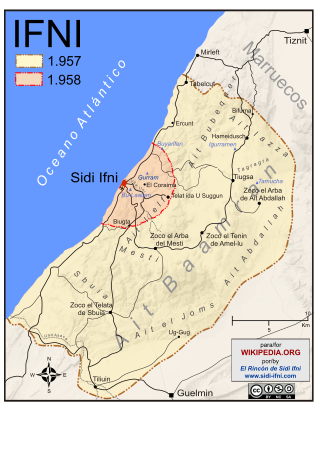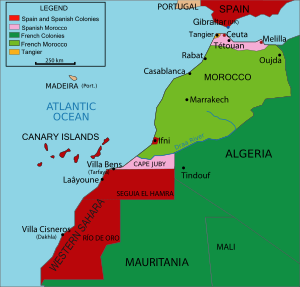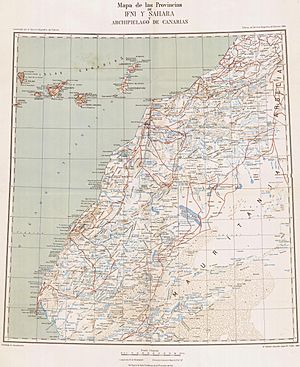Ifni War facts for kids
Quick facts for kids Ifni War |
|||||||||
|---|---|---|---|---|---|---|---|---|---|
| Part of the Decolonisation of Africa | |||||||||
 The borders of the Ifni territory before and after the war. |
|||||||||
|
|||||||||
| Belligerents | |||||||||
|
|
||||||||
| Commanders and leaders | |||||||||
| Strength | |||||||||
|
15,300 men
|
30,000 men | ||||||||
| Casualties and losses | |||||||||
| 190 dead 500 wounded 80 missing |
800–1,000 dead | ||||||||
| 7 civilian deaths | |||||||||
The Ifni War, also known as the Forgotten War in Spain, was a short conflict. It involved Moroccan fighters attacking areas controlled by Spain in West Africa. The fighting started in October 1957 and ended in June 1958.
The city of Sidi Ifni was given to the Spanish Empire in 1860 after a war. After Morocco became independent in 1956, it wanted to take back all of Spain's lands in West Africa. In April 1957, protests against Spanish rule happened in Ifni. By October, Moroccan fighters gathered near the area.
Moroccan forces attacked in November, making the Spanish army leave most of the land. The Spanish soldiers retreated to a safe area around Ifni city. The Spanish Navy brought supplies by sea, helping the Spanish soldiers hold out. This lasted until June 1958.
In the Spanish Sahara, Moroccan groups, now called the Moroccan Army of Liberation, fought hard battles. They fought Spanish forces in places like El Aaiún and Edchera. By February 1958, Spain and France worked together. Their attack pushed the Moroccans out of Spanish Sahara.
The fighting stopped in April 1958 with the Treaty of Angra de Cintra. Spain and Morocco signed this agreement. Under the treaty, Cape Juby and most of the Ifni area went to Morocco. The city of Sidi Ifni stayed with Spain until 1969. Then, because of international pressure, it was also given to Morocco.
Contents
Why the War Started
The city of Sidi Ifni was given to the Spanish Empire in 1860. This happened through a treaty, but Spain did not fully control it until 1934. Over the next years, Spain and France worked together. They set up and expanded the Spanish protectorate south of the city. In 1946, Spain's coastal and inland colonies became Spanish West Africa.
When Morocco became independent from France and Spain in 1956, it wanted all of Spain’s remaining colonies. Morocco believed these lands were historically part of its territory. Sultan Mohammed V of Morocco encouraged efforts to get these lands back. He even helped pay for people who wanted to fight against Spain. These included Moroccan fighters and local Berber rebels.
How the War Began
On April 10, 1957, violent protests against Spanish rule broke out in Ifni. People who supported Spain were attacked. In response, Spanish leader Francisco Franco sent two groups of soldiers from the Spanish Legion to El Aaiún. The Spanish Legion was Spain's best fighting force.
As Spain moved its soldiers, the Royal Moroccan Army gathered near Ifni. On October 23, 1957, about 1,500 Moroccan soldiers took over two villages near Sidi Ifni. These villages were Goulimine and Bouizakarne.
This surrounding of Ifni marked the start of the Ifni War. Two more groups of Legion soldiers arrived in Spanish Sahara before the main fighting began.
Attacks on Ifni
On November 21, Spanish spies in Ifni reported that attacks were coming soon. Moroccan fighters and local tribes from Tafraout were planning them. Two days later, Spanish communication lines were cut. Then, 2,000 Moroccans attacked Spanish military bases and weapon stores around Ifni.
The Moroccan attack on Sidi Ifni city was stopped. However, two Spanish outposts nearby had to be left because of the Moroccan attacks. Many other outposts were surrounded and under heavy attack.
Fighting at Tiluin
At Tiliuín, 60 local soldiers called Tiradores de Ifni fought against hundreds of Moroccans. These local soldiers had Spanish officers. On November 25, Spain tried to send help. Five Spanish bombers dropped bombs on enemy positions. Five transport planes dropped 75 paratroopers into the outpost. In the following months, Spanish troops moved back to a safe area around Sidi Ifni.
On December 3, soldiers from the Spanish Legion arrived. They broke the siege and took back the airfield. All soldiers and civilians were then moved by land to Sidi Ifni.
Fighting at Telata
Helping Telata was harder. On November 24, a group of Spanish paratroopers left Sidi Ifni in old trucks. They moved slowly through difficult land. Moroccan fighters often ambushed them, wounding several men. On November 26, they ran out of food. The Spanish, low on bullets, kept moving. But they had to stop and dig in again because of repeated enemy attacks.
Food was dropped from the air, but more Spanish soldiers were hurt or killed. Captain Ortiz de Zárate, their leader, was one of those who died. On December 2, a group of soldiers, including those who had defended Telata, broke through the Moroccan lines. They managed to escape being surrounded. The surviving paratroopers reached Sidi Ifni on December 5. The group had lost two men and had fourteen wounded.
Siege of Sidi Ifni
The first attacks by Moroccan and local tribes were largely successful. In just two weeks, the Moroccans and their allies took control of most of Ifni. They cut off Spanish units inland from the capital city. At the same time, attacks happened across Spanish Sahara. They took over military bases and ambushed convoys.
Because of this, Moroccan units, now with more supplies and soldiers, tried to surround Sidi Ifni. They hoped to start a local uprising. But the Moroccans did not realize how strong the Spanish defenses were. Sidi Ifni was supplied by the Spanish Navy from the sea. It was also protected by many kilometers of trenches and outposts. By December 9, it had 7,500 defenders and could not be captured. The siege lasted until June 1958. It was mostly quiet, as both Spain and Morocco focused on fighting in the Sahara.
Battle of Edchera
In January 1958, Morocco put more effort into the war. They renamed all their army units in Spanish territory the "Saharan Liberation Army".
On January 12, a part of the Saharan Liberation Army attacked the Spanish base at El Aaiún. The Spanish pushed them back. The Moroccan army then moved southeast. Another chance came the next day at Edchera. Two groups of Spanish Legion soldiers were on a scouting mission there. The Moroccans quietly slipped into the large sand dunes near the Spanish positions and opened fire.
The Spanish soldiers were ambushed. They struggled to stay together, fighting off attacks with mortars and small guns. One group of soldiers bravely held their ground until many were lost, forcing them to pull back. Bloody attacks continued until nightfall. The Spanish fought back fiercely, causing many Moroccan casualties. By nightfall, the Moroccans were too spread out and had lost too many men to keep fighting. They retreated into the darkness.
Clearing Spanish Sahara
In February 1958, France and Spain launched a joint attack. This attack broke up the Moroccan Liberation Army. Together, France and Spain used 150 planes. Spain had 9,000 soldiers, and France had 5,000.
The first places to fall were the Moroccan strongholds in the mountains at Tan-Tan. Bombed from the air and attacked from the ground, the Liberation Army lost 150 men and left their positions.
On February 10, several Spanish Legion groups, moving in vehicles, drove the Moroccans from Edchera. They then moved towards Tafurdat and Smara.
The Spanish army at El Aaiún, working with French forces, attacked the Moroccans on February 21. They destroyed groups of the Saharan Liberation Army between Bir Nazaran and Ausert.
What Happened After the War
On April 2, 1958, the governments of Spain and Morocco signed the Treaty of Angra de Cintra. This treaty was named after a large bay in the area.
Morocco gained the region of Tarfaya (Cape Juby). This area was between the Draa river and a certain line of latitude. Ifni was also given to Morocco, though Spain kept full control of the city until 1969. The treaty did not include the colony of Spanish Sahara.
Spain kept control of Sidi Ifni until 1969. Then, under pressure from other countries (like a United Nations resolution from 1965), Spain gave the territory back to Morocco. Spain kept control of Spanish Sahara until 1975. That year, the Green March happened, which led Spain to sign the Madrid Accords with Morocco and Mauritania. Spain left the territory in 1976. Western Sahara was then divided between Morocco and Mauritania.
| UN General Assembly Resolution 2072 (XX) |
|
|---|---|
| Date | 16 December 1965 |
| Meeting no. | 1398 |
| Code | A/RES/2072%28XX%29 (Document) |
| Subject | Ifni and Spanish Sahara |
| Result | Adopted |
See also
 In Spanish: Guerra de Ifni para niños
In Spanish: Guerra de Ifni para niños
- List of Spanish colonial wars in Morocco
- Green March
- Sahrawi nationalism



